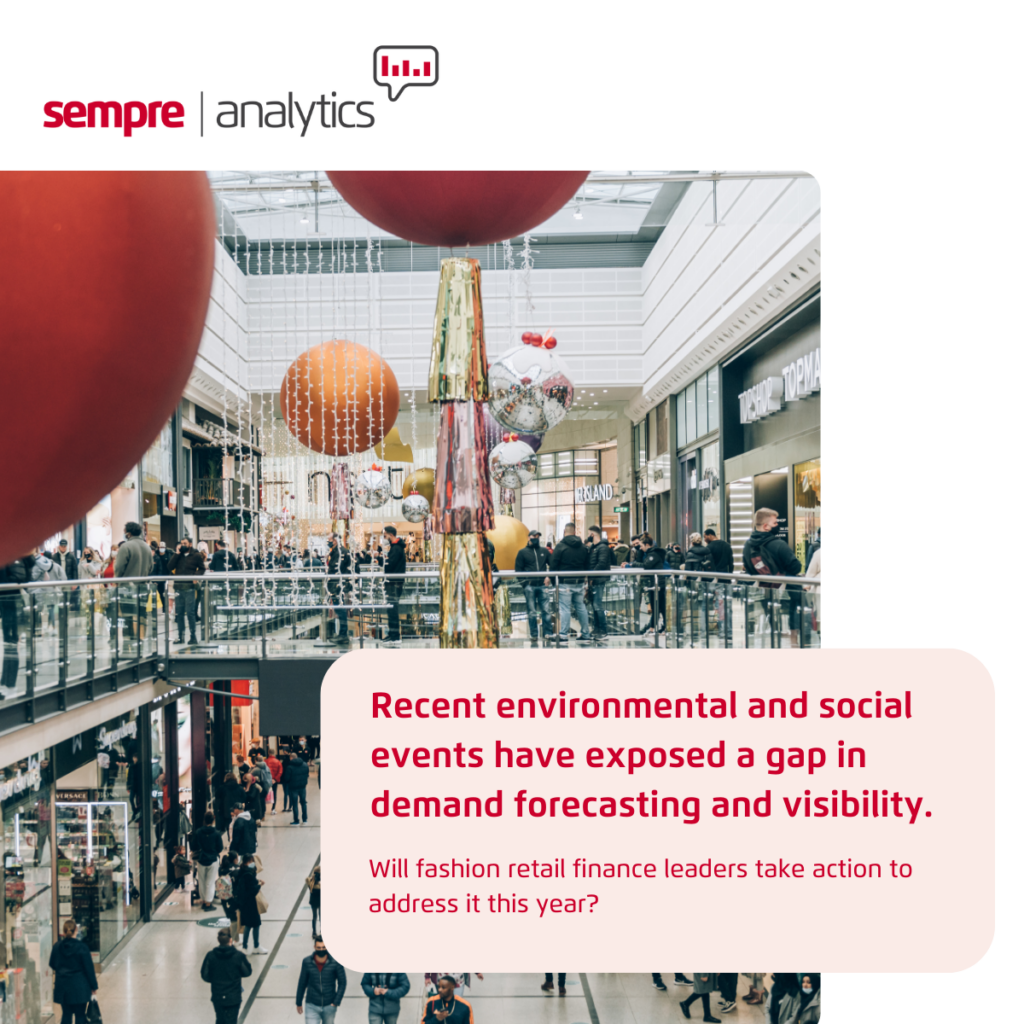
Clothing Retail: Without the Data, Where’s the Brand Resilience?
 Sempre has spent the last couple of years equipping apparel retailers to make rapid, informed decisions in an extremely tough operating environment.
Sempre has spent the last couple of years equipping apparel retailers to make rapid, informed decisions in an extremely tough operating environment.
Stephen Pass casts his eye on the biggest challenges the sector continues to face, from supply chain woes through to shifting consumer behaviour, and at how better utilisation of data is key to building brand resilience.
“Will I be able to get what I need at the point in time I intend to buy?” “Can I trust the delivery time estimate?” “Have I already left purchasing too late?…”
Clothing retail customers are asking the type of questions that are normally taken for granted.
On one level, it’s possible to regard the operational problems retailers face right now (e.g. congested ports, backlogged freight partners and staffing absences) as a one-off situation. Things will, of course, get better. But on another level, the last couple of years have brought cracks in the fashion retail model into sharp focus: things like unwieldy supply chains along with creaky decision-making processes, both of which make it extremely difficult to repivot inventory to match new circumstances and shifting demand.
Behaviour has also altered. As one example, not only are customers much more at home with e-commerce; they are also intensely relaxed with playing the returns game, ordering multiple items, knowing that a lot will be sent back. Easy returns are convenient for shoppers, but we know all too well from conversations with retailers that they can also be a huge stock management problem.
So once the immediate shipping backlogs have finally cleared, what comes next? Among the apparel retailers Sempre works with, and especially within the finance function, there’s a realisation that it shouldn’t be a case of business as usual. These brands want more effective ways to spot ripples in the data before they develop into full-blown problems. They want to break down silos across departments and sales channels. And if a new initiative is under discussion, finance managers want the ability to predict its likely impact across the whole business.
It’s all about building added resilience into the fashion retail model through more effective use of data. Examples include the following…

Supply chains: visibility and early warnings…
No brand can rely on the Covid excuse for stock shortages and late delivery forever; especially when your competitors appear to be doing things better.
Around half of consumers would use a different retailer in the future if an order arrived later than expected. According to Aptos, half of UK shoppers would ditch their favourite retailer if it didn’t stock the exact item they wanted. If something’s broken in your chain, customers are not going to wait for you to fix it.
In response, fashion retailers need to focus on two things: increasing visibility across what can often be tangled supply chains, and increasing their performance analysis and management capabilities, so that weak links can be addressed as early as possible. Some examples are as follows:
- Integrating data feeds from your various supply chain components into your ERM/data analytics system.
- Establishing what optimum supply chain performance actually looks like for your company, and ensuring the relevant KPIs are readily available via your dashboard (e.g. On-time Shipping Rate, Average Lead Times, Days of Supply, Freight Bill Accuracy).
- Regularly analysing the performance of each supplier and supply chain component (e.g. which ones are more prone to delay? If an issue arises at a particular point in the stream, how long does it take for this to impact fulfillment?
Customer sentiment vs stock: are you reading the room?
Drapers described how stock miscalculations had resulted in a disappointing Christmas for several big retailers. One company didn’t really know what was in its central distribution centre. Another brand’s inventory estimate had been massively overstated. One hadn’t anticipated the demise of skinny fit, while a further brand ran low on what turned out to be its most popular items. Collectively, these four household names had 170 years of procurement experience behind them.
So there’s a moral here: no matter your brand size or track-record, failure to track both stock and customer sentiment – and the relationship between the two – will always hit your bottom line.
Pre-pandemic, even among frequent online shoppers, most people still preferred to shop in-store for big-ticket apparel purchases. As an illustration of how this has changed, one fashion retailer tells us that the pandemic has seen them shift from an 80/20 in-store/online revenue split to something much closer to 50/50.
New buying habits and ever-more demanding customer expectations require an approach along the following lines:
The ability to harness and analyse data from right across the business and from external sources, side-by-side. This might include historic data to predict seasonal demand, as well as marketing data relating to budding trends, sentiment shifts, and behavioural changes. Predictive modeling can help you estimate the time it takes for a trend to translate into sales, and how this will impact demand for specific product lines.
The elimination of channel silos. Separate ‘stock pots’ for different channels, regions, or stores increase the risk of being faced with a glut in one area and shortages in another. If you can view inventory and sales data right across the business and drill into different levels, you can highlight variations (lines, sizes, colours, etc) and reallocate internally where necessary. After all, one of the best ways to respond to continued supply chain disruption is to ensure that what you do have is allocated to where it’s needed most.
If finance can harness the data, it can drive the strategy…
With apparel, if something makes good branding sense, it almost always makes good business sense.
So let’s say you wanted to create something akin to Charles Tyrwhitt’s ‘Made in England’ range. Near-shoring or on-shoring production and sourcing can potentially work on multiple levels. It reduces exposure to far-flung supplier disruption; it taps into a desire to support local producers, while also bringing added prestige to the brand.
But just how viable would such a project be? Whether it’s changing a supplier, moving to a new source of fuel for your fleet, addressing a gender pay disparity, or any of the other big choices your company is likely to face in the near future, the finance department is ideally positioned to guide the business towards the right decision.
Ideally, finance should aim for data integrated from across the organisation in a single source. So if a big decision is on the table, you can forecast with confidence what the implications will be right across the business, from workforce requirements and costs-per-unit, through to the impact on your bottom line.
From quicker, more accurate stock decisions through to predicting the impact of wider business change, Sempre specialises in helping retailers make the most of their data. For greater business resilience, speak to us today.
About the Author
Stephen Pass, Sector Lead – Insurance & Professional Services
Stephen is a Sector Lead for Insurance and Professional Services at Sempre Analytics. Stephen brings with him a strong data and analytic background, having held positions in leading global companies such as Teradata and Lloyds Banking Group, this awarded him valuable international experience in enterprise level software and services sales strategy.
Stephen’s deep experience solving business problems helped the Banking and Insurance industry make the best of opportunities from digitalisation. His strategic approach in identifying and understanding the market direction from the customer needs, alliances and the competitive landscape enabled his clients to develop their data analytics roadmap to become more operationally efficient and truly data-driven.











